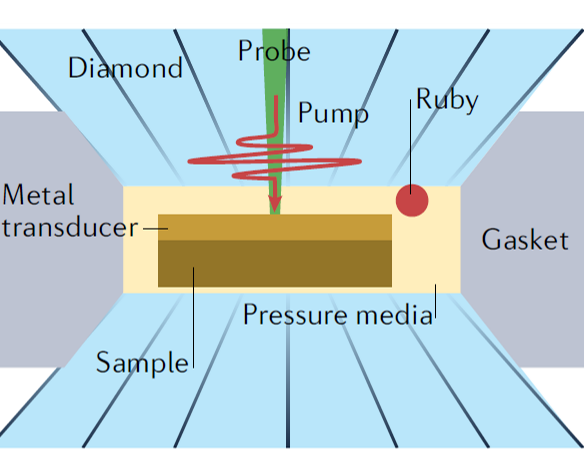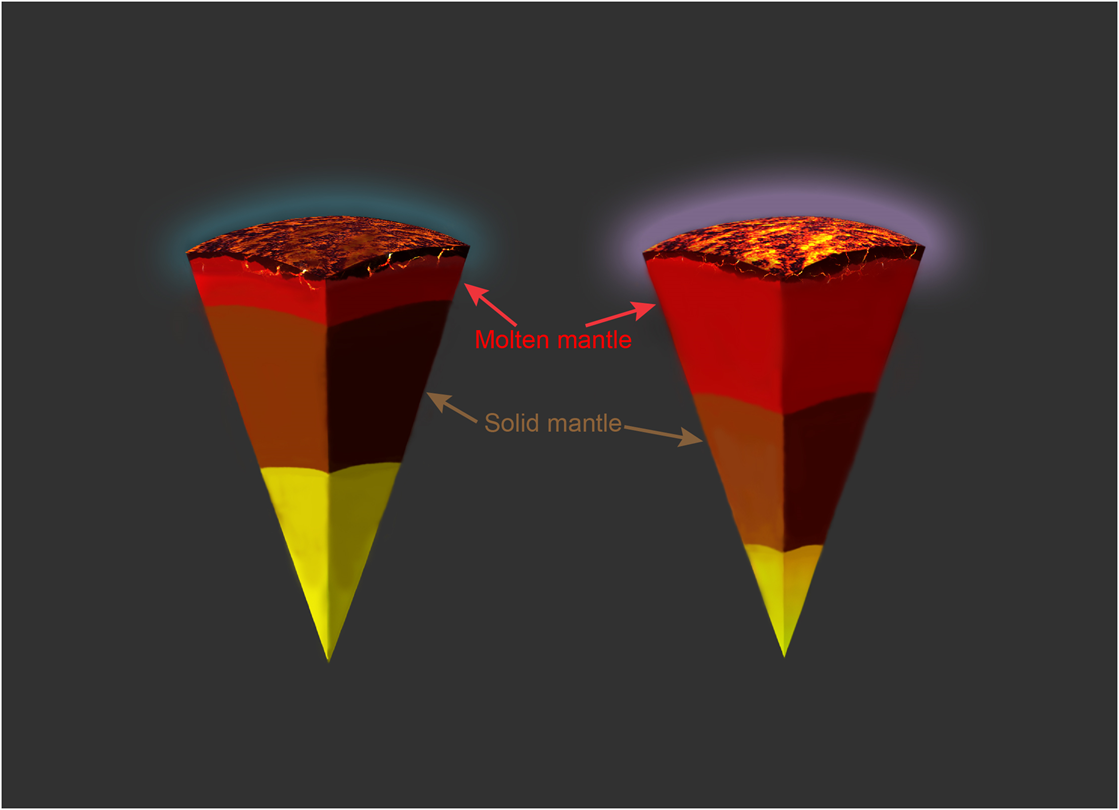

APRIL 30, 2022 — A team of researchers led by HPSTAR scientist Dr. Wenge Yang has recently used pressure-tuning to discover much richer transport properties emerging in a 400 nm thick bulk HgTe crystal, to rival the unique properties of its thin-film counterpart. Moreover, they also discovered superconductivity in a series of the bulk HgTe’s high-pressure phases. These fascinating results are...

APRIL 20, 2022 — Recently, a research team led by Drs. Ho-kwang Mao, Haiyan Zheng and Kuo Li from Center for High Pressure Science and Technology Advanced Research (HPSTAR) synthesized ultrafine diamond nanothreads with perfect carbon/nitrogen ordered structure through a distinctive reaction of aromatic systems under high pressure, and thus proposed a new method to synthesize more novel structure-...

APRIL 18, 2022 — Glass is everwhere around our life, like glass cup, and it has been made since ancient times. However, we still know very little about its structure in-depth due to confined characterization techniques. By making glass using berlinite crystals as starting materials, the team co-led by Dr. Qingyang Hu from HPSTAR proposed that a remaining topological ordering origin of glass and...

MARCH 18, 2022 — A research group co-led by Dr. Wenge Yang of HPSTAR, has employed ultrafast laser-initiated time-resolved X-ray diffraction (TR-XRD) (with a time resolution of 79 picosenconds) to directly track the structural evolution of a prototypical two-dimensional (2D) lead-free perovskite (Cs3Bi2Br9) upon photoexcitation. Their work, “Visualizing Light-Induced Microstrain and Phase...

FEBRUARY 21,2022 — Measuring and understanding the thermal conductivities of materials is essential for many practical applications we use daily, but what happens under high pressure? A new review paper of Thermal Conductivity of Materials under Pressure published recently in Nature Reviews Physics (online February 21st) by HPSTAR’s Dr. Xiaojia Chen summarizes the recent breakthroughs in high...

FEBRUARY 10, 2022 — Over the past several decades, it is widely thought that the Earth inner core is solid composed of iron alloy, but a team of scientists led by Center for High Pressure Science and Technology Advance Research (HPSTAR) and Institute of Geochemistry of CAS (GYIG) suggests that the inner core is not a conventionally known solid but a mixture of solid iron and light-element fluids....

JANUARY 18, 2022 — Materials with multi-stabilities controllable by external stimuli are potential for high-capacity information storage and switch devices. Second-harmonic-generation (SHG) as a distinct optical phenomenon is particularly suitable for information storage and readout, nevertheless, pressure-induced multi-step SHG switching material has rarely been reported. A research team led by ...

JANUARY 18, 2022 — Materials with zero-linear compression (ZLC) and zero-area compression (ZAC) hold great promises for specific applications retaining constant in specific directions or planes under external impaction. Up to now, no more than ten ZLC/ZAC materials have been reported, most of which are of very limited working pressure ranges (< 10 GPa). Herein, a pioneering work led by Dr. Ting...

JANUARY 6, 2022 — New work from a team of scientists co-led by Dr. Takayuki Ishii from HPSTAR reported that the large depressions of the 660-kilometre discontinuity in cold subduction zones is related to an extremely steep akimotoite-bridgmanite transition at low temperatures. The slab stagnation may also be casued by the significant upward buoyancy casued from this deeper and delayed transtion in...

DECEMBER 28, 2021 — New research by a team led by Dr. Haiyan Zheng from HPSTAR reports a completely functionalized crystalline polyacetylene produced using high-pressure techniques - the first crystalline poly-dicarboxylacetylene with every carbon on the trans-polyacetylene backbone bonded to a carboxyl group. Its unique structure combines the extremely high content of carbonyl groups and high...

DECEMBER 25, 2021 — Stimulus-responsive photoluminescent materials have attracted extensive research attention in recent years owing to their potential application in information storage and switch devices. Most of the materials that exhibit such phenomena are small organics, organometallic materials, liquid crystals, or polymer networks. At present, materials with high pressure sensitivity and...

DECEMBER 15, 2021 — New study from a team of scientists led by Dr. Qingyang Hu found that the high-conductivity and low-sound velocity of ε-FeOOH matched the features of heterogenous scatterers in the mid-lower mantle and such unique properties of hydrous ε-FeOOH, or possibly other Fe-enriched phases could be detected as evidence of active water transportation in the mid-lower mantle.

DECEMBER 15, 2021 — By combining the ultrasonic interferometry and multianvil press, a team of scientists led by Dr. Qigyang Hu from HPSTAR extended the research of diamond_sqlquote_s elasticity from kilobar to gigapascal pressures and showed that diamond became increasingly compressible, reaching agreement with theory. They pointed out the unique potential of diamond in providing an accurate,...

NOVEMBER 20, 2021 — New work by a team of scientists led by Dr. Kuo Li and Dr. Haiyan Zheng from HPSTAR have found that pressure gradients across various hydrogen-bearing compounds, such as γ-MnOOH, can promote dehydrogenation. The team proposes a pressure-gradient-driven battery through this process by separating the transferring routes of protons and electrons. The results are published in the...

NOVEMBER 25, 2021 — A team of researchers by Dr.Huiyang Gou from HPSTAR and Dr. Howard Sheng from George Mason University in collaboration with Prof. Tomo Katsura at University Bayreuth, Prof. Mingsheng Wang at Xiamen University and Dr. Zhidan Zeng at HPSTAR, have discovered a new form of diamond that could fundamentally challenge our ideas about the nature of solids. This new member of the...

NOVEMBER 24, 2021 — A research team led by Dr. Hengzhong Zhang from the Center for High Pressure Science and Technology Advanced Research (HPSTAR) revealed that a new Cu-bearing van der Waals compound CuP2Se can be metallized and then turned into a superconductor accompanying a series of structural changes under compression. Their study illustrates that pressure can be used to harvest useful...

NOVEMBER 4, 2021 — New work published in the Proceedings of the National Academy of Sciences by HPSTAR’s Yanhao Lin and Ho-Kwang “Dave” Mao — with collaborator Wim van Westrenen of Vrije Universiteit Amsterdam — demonstrates that oxygen is essential for rock to melt, and the more oxygen you add to rock, the more easily you can make magma.

AUGUST 20, 2021 — Carbon exhibits a vast variety of allotropic forms stemming from its different chemical bonding motifs - from well-known graphite and diamond, to fullerenes and carbon nanotubes build of nanometer-sized structural units. In this row diamond possesses a “special” place being the hardest known natural material on Earth. This status-quo remained until a research team from Yanshan...

SEPTEMBER 16, 2021 — The correlation between superconductivity and a disordered structure is an interesting and challenging topic in condensed matter physics. Although scientists discovered amorphous superconductors as early as 1954, their superconducting mechanism has remained mysterious due to their complex chemical and structural disorder, and limited investigative experimental techniques under...

SEPTEMBER 2, 2021 — Semiconductors were widely used in manufacturing chops, solar cells, photovoltaic devices and so on, which have defined the third industrial revolution since the late 1900s. Although a large number of semiconductor materials are in production, people are still seeking new semiconductor materials with higher energy conversion efficiency. Choices for environmentally friendly and ...